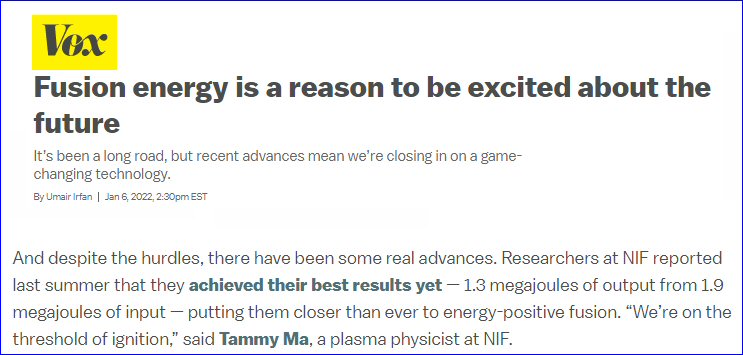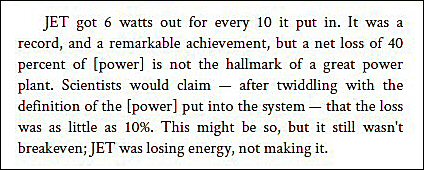#116 How Fusion Representatives Created the Power Deception
Return to ITER Power Facts Main Page
By Steven B. Krivit
April 9, 2022
In this article, I will explain how representatives of the nuclear fusion community caused so many people to misunderstand the power specifications of experimental fusion reactors. The fusion fuel deception is an equally important issue, but I have covered that matter in this summary article and its subordinate articles.
In order to keep this article as concise as possible, I’m going to focus on the underlying concepts the representatives used rather than their specific activities. I’ve covered such activities in my documentary film “ITER, The Grand Illusion: A Forensic Investigation of Power Claims.”
The entire nuclear fusion community did not actively participate in the power deception. Only a few of their representatives were directly responsible. However, the rest of the fusion community, with few exceptions, passively allowed it to happen.
For people who are new to the subject, I will first show some examples to provide a sense of how significant this deception was.
National Ignition Facility
The Lawrence Livermore National Laboratory’s National Ignition Facility (NIF) announced new results in August 2021. Scientists at NIF caused the news organization Vox, for example, to tell its readers and viewers that the NIF laser fusion device came very close to producing net energy. Vox told its audience that the NIF experiment produced an output of 1.3 megajoules of energy with an input of 1.9 megajoules. 1.3 megajoules is enough energy to boil one kettle of water.
The Vox journalists did not understand — and it was by no means their fault — that the NIF laser fusion device actually consumed 400 megajoules of energy. I explained the exact details of how the laboratory created this misunderstanding in an Aug. 8, 2021, article as well as in three follow-up articles starting on Feb. 2, 2022.

The NIF scientists didn’t trick only journalists. They also tricked American professor of theoretical physics and television personality Michio Kaku into thinking that the NIF device produced fusion reactions that released 70 percent of the energy consumed by the device. Kaku spoke on CNBC in August 2021. Kaku didn’t realize that laser fusion scientists at NIF have four definitions for breakeven. Kaku inadvertently led viewers to believe that the NIF device (not just the fusion reaction) “hit breakeven: to extract more energy than you put in.” With 400 megajoules in and 1.3 megajoules out, the NIF device didn’t come close.
Joint European Torus
Fusion scientists misled journalist and author Charles Seife about the Joint European Torus (JET) reactor which produced the most powerful fusion output in the world 25 years ago.
Seife thought, as he wrote in his 2009 book Sun in a Bottle, that JET was not the hallmark of a great power plant because it produced an output of only 6 Watts for every 10 Watts it consumed. The common belief was that JET produced 16 MW from a total input of 24 MW of electricity. How far did JET scientists spin the facts? JET consumed 700 MW of electricity. JET produced fusion reactions with only two percent of the power the reactor consumed.

International Thermonuclear Experimental Reactor
Science magazine journalist Daniel Clery has written many articles about ITER, the International Thermonuclear Experimental Reactor. Clery describes himself as someone with “a long pedigree in science journalism.”
In 2006, Clery told readers of Science that “ITER aims to produce 500 megawatts of power, 10 times the amount needed to keep it running.”
In 2013, he told readers that “no reactor has yet produced net energy gain.” He wrote, “ITER is expected to break through that barrier and generate 500 megawatts from a 50 MW input.”
In 2020, he told readers that “ITER is designed to show net energy output can be achieved.”
Actually, the ITER reactor is designed to consume 500 MW of electricity to start and then use 300 to 440 MW throughout the experiment. This will leave nothing left over, with no net energy for the overall device, because the planned 500 MW thermal output is equivalent to 200 MW electrical output.
How They Did It
How were fusion scientists so effective in deceiving so many smart people? The key was their use of terms that have double meanings. Among them, the No. 1 most-effective method was their use of the phrase “fusion power.” There are two examples in the image below.

False claims made by the ITER organization, as published on its Web site, before Oct. 6, 2017 (Click here to see ITER organization’s correction soon after Oct. 5, 2017)
#1. Fusion Power vs. Fusion Power
The practical meaning of the phrase “fusion power” is the net power produced by a fusion reactor. The scientific meaning of “fusion power” is the gross thermal power produced by fusion reactions.
The first meaning includes the power required to operate a fusion reactor. The second meaning excludes the required operating power. The fusion community elected not to explain or define this distinction or even advise the public of the existence of the second meaning. The ambiguity worked in the community’s favor. It caused most people to think, using JET as an example, that the reactor produced 16 MW of fusion power when, in fact, it produced only reactions with 16 MW of fusion power. In that sentence, there’s no way that anybody but an expert can tell the difference. Because members of the public knew only one meaning of the phrase “fusion power,” that’s the only meaning they ascribed to “fusion power.”
For more-technical readers: It did not help that fusion representatives added “(Q=10)” in promotional literature, as shown above, because most members of the public did not know anything about “Q.” There was no way for the public to understand that, in these instances, “Q” was supposed to mean Qscientific. Moreover, language as shown above — “from a total input power” — associated “Q” to the wrong Q-value, to Qengineering. Ordinarily, “Q” by itself is associated with Qscientific. By their pervasive association of “Q” with “total input power,” the fusion representatives, in fact, co-opted the meaning of “Q” to imply Qengineering.
#2. Misleading Purpose of Research
Hand-in-hand with the systemic ambiguity of the phrase “fusion power” was the fact that fusion scientists were ambiguous when speaking with the public about the purpose of fusion research. For most of the 70-year duration of the research, scientists implied that their goal was net reactor power. But none of the 100-plus fusion reactors was ever designed to obtain net reactor power output. The goal was always (except until recently) net reaction power output.
#3. Misleading Input Power Values
Whenever fusion scientists told members of the public any input power value, they always gave a power value representing the injected heating power used to heat the fuel. But the scientists rarely explained that to the public. That’s what the “24 MW” and “50 MW” values mean in the example above. Instead, the scientists implied that those values were the required input power to operate the JET and ITER reactors, respectively. In the JET example above, it was more than just implied. They said “total input power.” The fusion community almost never explained that these values — “24 MW” and “50 MW” — represented the injected heating power until I publicly explained the problem in 2018.
#4. Omitted Reactor Input Power Values
In order to complete the false appearance that injected heating power values, like “24 MW” and “50 MW,” represented the total input power value for the reactors, one more component was needed: the complete public omission of the real input power required to operate the reactors. And that’s how this whole house of cards fell apart when, by accident, on Dec. 1, 2014, I learned how much power JET required.
The Fusion Fuel Deception
Equally important to the power deception is the fuel deception. Many fusion scientists and their publicists have told investors and members of the public that the fuel for deuterium-tritium fusion reactors is “abundant, virtually inexhaustible, and equally accessible to everyone.” Nothing could be further from the truth.
Although deuterium is abundant and available as a natural resource, tritium is not. Some fusion scientists say that they can produce all the tritium they need for fusion reactors by breeding tritium from lithium. This claim is not supported by the science. There is no known way to breed tritium fast enough from enriched lithium. There is also no known legal, non-toxic way to produce the necessary industrial quantities of enriched lithium. The scientists know this. Some of them have been transparent about communicating it. Others have not. One of the victims of the fuel deception was Michio Kaku, as revealed when he spoke on CNBC about NIF in 2021.
Here’s what Kaku said about fusion fuel: “And the fuel — the fuel is seawater! Hydrogen from seawater could be the basic fuel. So this is too good to be true.”
Yes, it is too good to be true. A good place to start to understand the fuel deception is my article “The Fuel for Nuclear Fusion Doesn’t Exist.”

